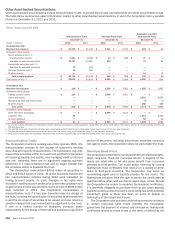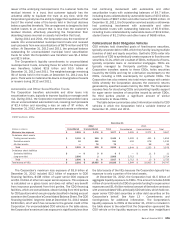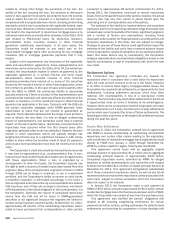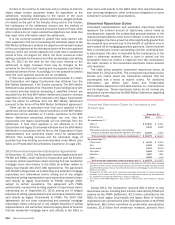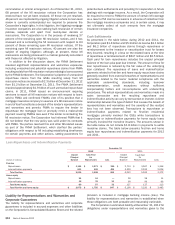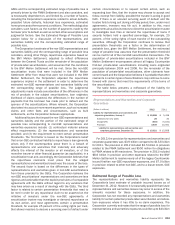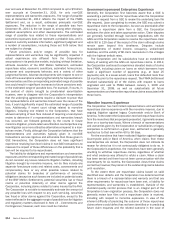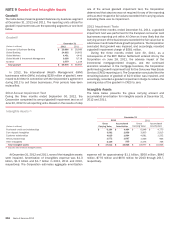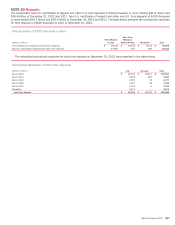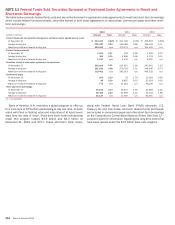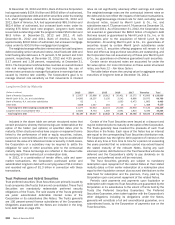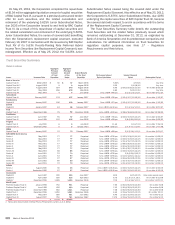Bank of America 2012 Annual Report Download - page 215
Download and view the complete annual report
Please find page 215 of the 2012 Bank of America annual report below. You can navigate through the pages in the report by either clicking on the pages listed below, or by using the keyword search tool below to find specific information within the annual report.
Bank of America 2012 213
GSEs and the corresponding estimated range of possible loss is
primarily driven by the FNMA Settlement and also considers, and
is necessarily dependent on, and limited by, a number of factors,
including the Corporation’s experience related to actual defaults,
projected future defaults, historical loss experience, estimated
home prices and other economic conditions. The methodology also
considers such factors as the number of payments made by the
borrower prior to default as well as certain other assumptions and
judgmental factors. See the Estimated Range of Possible Loss
section below for a discussion of the representations and
warranties liability and the corresponding estimated range of
possible loss.
The Corporation’s estimate of the non-GSE representations and
warranties liability and the corresponding range of possible loss
considers, among other things, repurchase experience based on
the BNY Mellon Settlement, adjusted to reflect differences
between the Covered Trusts and the remainder of the population
of private-label securitizations, and assumes that the conditions
to the BNY Mellon Settlement will be met. Since the non-GSE
securitization trusts that were included in the BNY Mellon
Settlement differ from those that were not included in the BNY
Mellon Settlement, the Corporation adjusted the repurchase
experience implied in the settlement in order to determine the
estimated non-GSE representations and warranties liability and
the corresponding range of possible loss. The judgmental
adjustments made include consideration of the differences in the
mix of products in the subject securitizations, loan originator,
likelihood of claims expected, the differences in the number of
payments that the borrower has made prior to default and the
sponsor of the securitizations. Where relevant, the Corporation
also takes into account more recent experience, such as increased
claims and other facts and circumstances, such as bulk
settlements, as the Corporation believes appropriate.
Additional factors that impact the non-GSE representations and
warranties liability and the portion of the estimated range of
possible loss corresponding to non-GSE representations and
warranties exposures include: (1) contractual material adverse
effect requirements; (2) the representations and warranties
provided; and (3) the requirement to meet certain presentation
thresholds. The first factor is based on the Corporation’s belief
that a non-GSE contractual liability to repurchase a loan generally
arises only if the counterparties prove there is a breach of
representations and warranties that materially and adversely
affects the interest of the investor or all investors, or of the
monoline insurer or other financial guarantor (as applicable), in a
securitization trust and, accordingly, the Corporation believes that
the repurchase claimants must prove that the alleged
representations and warranties breach was the cause of the loss.
The second factor is based on the differences in the types of
representations and warranties given in non-GSE securitizations
from those provided to the GSEs. The Corporation believes the
non-GSE securitizations’ representations and warranties are less
rigorous and actionable than the explicit provisions of comparable
agreements with the GSEs without regard to any variations that
may have arisen as a result of dealings with the GSEs. The third
factor is related to certain presentation thresholds that need to
be met in order for any repurchase claim to be asserted on the
initiative of investors under the non-GSE agreements. A
securitization trustee may investigate or demand repurchase on
its own action, and most agreements contain a presentation
threshold, for example 25 percent of the voting rights per trust,
that allows investors to declare a servicing event of default under
certain circumstances or to request certain action, such as
requesting loan files, that the trustee may choose to accept and
follow, exempt from liability, provided the trustee is acting in good
faith. If there is an uncured servicing event of default and the
trustee fails to bring suit during a 60-day period, then, under most
agreements, investors may file suit. In addition to this, most
agreements also allow investors to direct the securitization trustee
to investigate loan files or demand the repurchase of loans if
security holders hold a specified percentage, for example, 25
percent, of the voting rights of each tranche of the outstanding
securities. Although the Corporation continues to believe that
presentation thresholds are a factor in the determination of
probable loss, given the BNY Mellon Settlement, the estimated
range of possible loss assumes that the presentation threshold
can be met for all of the non-GSE securitization transactions. The
population of private-label securitizations included in the BNY
Mellon Settlement encompasses almost all legacy Countrywide
first-lien private-label securitizations including loans originated
principally between 2004 and 2008. For the remainder of the
population of private-label securitizations, other claimants have
come forward and the Corporation believes it is probable that other
claimants in certain types of securitizations may continue to come
forward with claims that meet the requirements of the terms of
the securitizations.
The table below presents a rollforward of the liability for
representations and warranties and corporate guarantees.
Representations and Warranties and Corporate
Guarantees
(Dollars in millions) 2012 2011
Liability for representations and warranties and
corporate guarantees, January 1 $ 15,858 $ 5,438
Additions for new sales 28 20
Charge-offs (804) (5,191)
Provision 3,939 15,591
Liability for representations and warranties and
corporate guarantees, December 31 $ 19,021 $ 15,858
For 2012, the provision for representations and warranties and
corporate guarantees was $3.9 billion compared to $15.6 billion
for 2011. The provision in 2012 included $2.5 billion in provision
related to the FNMA Settlement and $500 million for obligations
to FNMA related to MI rescissions. The provision in 2011 included
$8.6 billion in provision and other expenses related to the BNY
Mellon Settlement to resolve nearly all of the legacy Countrywide-
issued first-lien non-GSE repurchase exposures, and $7.0 billion
in provision related to other non-GSE, and to a lesser extent, GSE
exposures.
Estimated Range of Possible Loss
The representations and warranties liability represents the
Corporation’s best estimate of probable incurred losses as of
December 31, 2012. However, it is reasonably possible that future
representations and warranties losses may occur in excess of the
amounts recorded for these exposures. In addition, the
Corporation has not recorded any representations and warranties
liability for certain potential private-label securitization and whole-
loan exposures where it has little to no claim experience. The
Corporation currently estimates that the range of possible loss for
representations and warranties exposures could be up to $4 billion



